#east atlanta village
Explore tagged Tumblr posts
Text
08.24.24 #ATLHOE
instagram
#529EAV#SPEAKEASY PROMOTIONS#EDDIE MEEKS#J-LIVE#SCIENZ OF LIFE#SUPASTITION#DYNAS#DJ DUG BOOGIE#FORT KNOX#ATL#ATLANTA#EAST ATLANTA VILLAGE#Instagram
0 notes
Text

Come out to 529 and rock out Sydney style !
0 notes
Text
Colours...

Artfully arranged via @grumpygitsinteriorworld
#interior design#foyerdecor#design#elle japan#elledecor#elle italia#elle decor#upper east side#greenwich village#new york#san francisco#santoni#spain#sprezzatura#gq spain#france#africa#italian style#southern italy#palermo sicily#atlanta#interior#interiordesign#interesting#inspiration#interiors#homeinterior#apartment#pininfarina#home interior
47 notes
·
View notes
Text

Ben, 20
“My bag is Balenciaga, hat is from Miniso, sweater is this Atlanta brand Mind Bowling and the vest Hyein Seo, also wearing Jncos and Nike Sacais. I don’t like to put limits on myself, like I’m wearing every color of the rainbow. I want to be a living 3d animation. I love Moschino, Teso Life, and Trash and Vaudeville. I want to make a younger version of myself proud.”
Mar 17, 2024 ∙ East Village
#nyc looks#street style#street fashion#street snap#clothes#style#outfit#fashion#balenciaga#hyein seo#jnco jeans
503 notes
·
View notes
Text
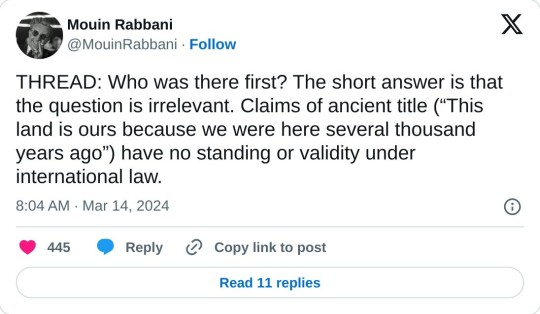
twitter thread by Mouin Rabbani
March 14, 2024
Who was there first? The short answer is that the question is irrelevant. Claims of ancient title (“This land is ours because we were here several thousand years ago”) have no standing or validity under international law.
For good reason, because such claims also defy elementary common sense. Neither I nor anyone reading this post can convincingly substantiate the geographical location of their direct ancestors ten or five or even two thousand years ago.
If we could, the successful completion of the exercise would confer exactly zero property, territorial, or sovereign rights.
As a thought experiment, let’s go back only a few centuries rather than multiple millennia. Do South Africa’s Afrikaners have the right to claim The Netherlands as their homeland, or even qualify for Dutch citizenship, on the basis of their lineage?
Do the descendants of African-Americans who were forcibly removed from West Africa have the right to board a flight in Atlanta, Port-au-Prince, or São Paolo and reclaim their ancestral villages from the current inhabitants, who in all probability arrived only after – perhaps long after – the previous inhabitants were abducted and sold into slavery half a world away?
Do Australians who can trace their roots to convicts who were involuntarily transported Down Under by the British government have a right to return to Britain or Ireland and repossess homes from the present inhabitants even if, with the help of court records, they can identify the exact address inhabited by their forebears? Of course not.
In sharp contrast to, for example, Native Americans or the Maori of New Zealand, none of the above can demonstrate a living connection with the lands to which they would lay claim.
To put it crudely, neither nostalgic attachment nor ancestry, in and of themselves, confer rights of any sort, particularly where such rights have not been asserted over the course of hundreds or thousands of years.
If they did, American English would be the predominant language in large parts of Europe, and Spain would once again be speaking Arabic.
Nevertheless, the claim of ancient title has been and remains central to Zionist assertions of not only Jewish rights in Palestine, but of an exclusive Jewish right to Palestine.
For the sake of argument, let’s examine it. If we put aside religious mythology, the origin of the ancient Israelites is indeed local.
In ancient times it was not unusual for those in conflict with authority or marginalized by it to take to the more secure environment of surrounding hills or mountains, conquer existing settlements or establish new ones, and in the ultimate sign of independence adopt distinct religious practices and generate their own rulers. That the Israelites originated as indigenous Canaanite tribes rather than as fully-fledged monotheistic immigrants or conquerors is more or less the scholarly consensus, buttressed by archeological and other evidence. And buttressed by the absence of evidence for the origin stories more familiar to us.
It is also the scholarly consensus that the Israelites established two kingdoms, Judah and Israel, the former landlocked and covering Jerusalem and regions to the south, the latter (also known as the Northern Kingdom or Samaria) encompassing points north, the Galilee, and parts of contemporary Jordan. Whether these entities were preceded by a United Kingdom that subsequently fractured remains the subject of fierce debate.
What is certain is that the ancient Israelites were never a significant regional power, let alone the superpower of the modern imagination.
There is a reason the great empires of the Middle East emerged in Egypt, Mesopotamia, Persia, and Anatolia – or from outside the region altogether – but never in Palestine.
It simply lacked the population and resource base for power projection. Jerusalem may be the holiest of cities on earth, but for almost the entirety of its existence, including the period in question, it existed as a village, provincial town or small city rather than metropolis.
Judah and Israel, like the neighboring Canaanite and Philistine entities during this period, were for most of their existence vassal states, their fealty and tribute fought over by rival empires – Egyptians, Assyrians, Babylonians, etc. – rather than extracted from others.
Indeed, Israel was destroyed during the eighth century BCE by the Assyrians, who for good measured subordinated Judah to their authority, until it was in the sixth century BCE eliminated by the Babylonians, who had earlier overtaken the Assyrians in a regional power struggle.
The Babylonian Exile was not a wholesale deportation, but rather affected primarily Judah’s elites and their kin. Nor was there a collective return to the homeland when the opportunity arose several decades later after Cyrus the Great defeated Babylon and re-established a smaller Judah as a province of the Persian Achaemenid empire. Indeed, Mesopotamia would remain a key center of Jewish religion and culture for centuries afterwards.
Zionist claims of ancient title conveniently erase the reality that the ancient Israelites were hardly the only inhabitants of ancient Palestine, but rather shared it with Canaanites, Philistines, and others.
The second part of the claim, that the Jewish population was forcibly expelled by the Romans and has for 2,000 years been consumed with the desire to return, is equally problematic.
By the time the Romans conquered Jerusalem during the first century BCE, established Jewish communities were already to be found throughout the Mediterranean world and Middle East – to the extent that a number of scholars have concluded that a majority of Jews already lived in the diaspora by the time the first Roman soldier set foot in Jerusalem.
These communities held a deep attachment to Jerusalem, its Temple, and the lands recounted in the Bible. They identified as diasporic communities, and in many cases may additionally have been able to trace their origins to this or that town or village in the extinguished kingdoms of Israel and Judah. But there is no indication those born and bred in the diaspora across multiple generations considered themselves to be living in temporary exile or considered the territory of the former Israelite kingdoms rather than their lands of birth and residence their natural homeland, any more than Irish-Americans today feel they properly belong in Ireland rather than the United States.
Unlike those taken in captivity to Babylon centuries earlier, there was no impediment to their relocation to or from their ancestral lands, although economic factors appear to have played an important role in the growth of the diaspora.
By contrast, those traveling in the opposite direction appear to have done so, more often than not, for religious reasons, or to be buried in Jerusalem’s sacred soil.
Nations and nationalism did not exist 2,000 years ago.
Nor Zionist propagandists in New York, Paris, and London incessantly proclaiming that for two millennia Jews everywhere have wanted nothing more than to return their homeland, and invariably driving home rather than taking the next flight to Tel Aviv.
Nor insufferably loud Americans declaring, without a hint of irony or self-awareness, the right of the Jewish people to Palestine “because they were there first”.
Back to the Romans, about a century after their arrival a series of Jewish rebellions over the course of several decades, coupled with internecine warfare between various Jewish factions, produced devastating results.
A large proportion of the Jewish population was killed in battle, massacred, sold into slavery, or exiled. Many towns and villages were ransacked, the Temple in Jerusalem destroyed, and Jews barred from entering the city for all but one day a year.
Although a significant Jewish presence remained, primarily in the Galilee, the killings, associated deaths from disease and destitution, and expulsions during the Roman-Jewish wars exacted a calamitous toll.
With the destruction of the Temple Jerusalem became an increasingly spiritual rather than physical center of Jewish life. Jews neither formed a demographic majority in Palestine, nor were the majority of Jews to be found there.
Many of those who remained would in subsequent centuries convert to Christianity or Islam, succumb to massacres during the Crusades, or join the diaspora. On the eve of Zionist colonization locally-born Jews constituted less than five per cent of the total population.
As for the burning desire to return to Zion, there is precious little evidence to substantiate it. There is, for example, no evidence that upon their expulsion from Spain during the late fifteenth century, the Sephardic Jewish community, many of whom were given refuge by the Ottoman Empire that ruled Palestine, made concerted efforts to head for Jerusalem. Rather, most opted for Istanbul and Greece.
Similarly, during the massive migration of Jews fleeing persecution and poverty in Eastern Europe during the nineteenth century, the destinations of choice were the United States and United Kingdom.
Even after the Zionist movement began a concerted campaign to encourage Jewish emigration to Palestine, less than five per cent took up the offer. And while the British are to this day condemned for limiting Jewish immigration to Palestine during the late 1930s, the more pertinent reality is that the vast majority of those fleeing the Nazi menace once again preferred to relocate to the US and UK, but were deprived of these havens because Washington and London firmly slammed their doors shut.
Tellingly, the Jewish Agency for Israel in 2023 reported that of the world’s 15.7 million Jews, 7.2 million – less than half – reside in Israel and the occupied Palestinian territories.
According to the Agency, “The Jewish population numbers refer to persons who define themselves as Jews by religion or otherwise and who do not practice another religion”.
It further notes that if instead of religion one were to apply Israel’s Law of Return, under which any individual with one or more Jewish grandparent is entitled to Israeli citizenship, only 7.2 of 25.5 million eligible individuals (28 per cent) have opted for Zion.
In other words, “Next Year in Jerusalem” was, and largely remains, an aspirational religious incantation rather than political program. For religious Jews, furthermore, it was to result from divine rather than human intervention.
For this reason, many equated Zionism with blasphemy, and until quite recently most Orthodox Jews were either non-Zionist or rejected the ideology altogether.
Returning to the irrelevant issue of ancestry, if there is one population group that can lay a viable claim of direct descent from the ancient Israelites it would be the Samaritans, who have inhabited the area around Mount Gerizim, near the West Bank city of Nablus, without interruption since ancient times.
Palestinian Jews would be next in line, although unlike the Samaritans they interacted more regularly with both other Jewish communities and their gentile neighbors.
Claims of Israelite descent made on behalf of Jewish diaspora communities are much more difficult to sustain. Conversions to and from Judaism, intermarriage with gentiles, absorption in multiple foreign societies, and related phenomena over the course of several thousand years make it a virtual certainty that the vast majority of Jews who arrived in Palestine during the late 19th and first half of the 20th century to reclaim their ancient homeland were in fact the first of their lineage to ever set foot in it.
By way of an admittedly imperfect analogy, most Levantines, Egyptians, Sudanese, and North Africans identify as Arabs, yet the percentage of those who can trace their roots to the tribes of the Arabian Peninsula that conquered their lands during the seventh and eighth centuries is at best rather small.
Ironically, a contemporary Palestinian, particularly in the West Bank and Galilee, is likely to have more Israelite ancestry than a contemporary diaspora Jew.
The Palestinians take their name from the Philistines, one of the so-called Sea Peoples who arrived on the southern coast of Canaan from the Aegean islands, probably Crete, during the late second millennium BCE.
They formed a number of city states, including Gaza, Ashdod, and Ashkelon. Like Judah and Israel they existed primarily as vassals of regional powers, and like them were eventually destroyed by more powerful states as well.
With no record of their extermination or expulsion, the Philistines are presumed to have been absorbed by the Canaanites and thereafter disappear from the historical record.
Sitting at the crossroads between Asia, Africa, and Europe, Palestine was over the centuries repeatedly conquered by empires near and far, absorbing a constant flow of human and cultural influences throughout.
Given its religious significance, pilgrims from around the globe also contributed to making the Palestinian people what they are today.
A common myth is that the Palestinian origin story dates from the Arab-Muslim conquests of the seventh century. In point of fact, the Arabs neither exterminated nor expelled the existing population, and the new rulers never formed a majority of the population.
Rather, and over the course of several centuries, the local population was gradually Arabized, and to a large extent Islamized as well.
So the question as to who was there first can be answered in several ways: “both” and “irrelevant” are equally correct.
Indisputably, the Zionist movement had no right to establish a sovereign state in Palestine on the basis of claims of ancient title, which was and remains its primary justification for doing so.
That it established an exclusivist state that not only rejected any rights for the existing Palestinian population but was from the very outset determined to displace and replace this population was and remains a historical travesty.
That it as a matter of legislation confers automatic citizenship on millions who have no existing connection with the land but denies it to those who were born there and expelled from it, solely on the basis of their identity, would appear to be the very definition of apartheid.
The above notwithstanding, and while the Zionist claim of exclusive Israeli sovereignty in Palestine remains illegitimate, there are today several million Israelis who cannot be simply wished away.
A path to co-existence will need to be found, even as the genocidal nature of the Israeli state, and increasingly of Israeli society as well, makes the endeavor increasingly complicated.
The question, thrown into sharp relief by Israel’s genocidal onslaught on the Palestinian population of the Gaza Strip, is whether co-existence with Israeli society can be achieved without first dismantling the Israeli state and its ruling institutions.
258 notes
·
View notes
Text

December 27th, 2008 is the day Anik Pillai was left behind. Trying to find his family, he travels the East Coast with his new friends, avoiding the bloodthirsty monsters created by a world-ending virus. ⠀⠀⠀🌹
⠀⠀
⠀
🌹 Season 1: 5 months (Jan-May)
⠀Anik Pillai, separated from his sister, makes friendly with multiple people in the chaos of the collapse of society. In this chaos, Anik raises a little boy who was also separated from his family.
1. Destroy My Life | 2. Fueling | 3. More Tigers in Captivity than the Wild | 4. Avtomat Kalashnikova | 5. The Goliath | 6. Soup | 7. A Completely, Totally, Safe Place | 8. Distrust Him | 9. Theatrics | 10. Shape & Scissor
⠀
🌹 Season 2: 1 month (June)
⠀Anik and his friends try to escape the city before it is bombed by the remnants of the United States’ government.
1. Nirvana | 2. Is There Anyone Coming For Him? | 3. Raccoon Dye | 4. The Ever-Changing Menu | 5. Top Secret | 6. Hordes Form Hordes | 7. A Nice Walk in the Park | 8. Napalm | 9. Crossing Paths | 10. Down the Fifteen Stories
⠀
🌹 Season 3: 2 months (July-August)
⠀Still unable to find his sister & parents, Anik and friends meet a capable married couple, and head to a safe settlement called Wheatville.
1. The Pillai Residence | 2. Another New Acquaintence | 3. I Like Them Scrambled! | 4. Meatballs | 5. Childhood, Weddings, & Forgetfulness | 6. A Most Severe Evil | 7. The Barricade | 8. Wheatfields of Wheatville | 9. Be True, and They Will Follow | 10. He'll Be Leaving Here - With You.
⠀
🌹 Season 4: 1 month (September)
⠀The main group learn more about the state of society and science after the fall.
1. The Skin Boils Beneath, Holding Visions | 2. To Wish Impossible Things | 3. Lumbar Puncture | 4. Fever Dream | 5. Meatfillings | 6. Separation Anxiety | 7. Wise Serpent and Harmless Dove | 8. X | 9. Round and Round They Go | 10. The Doctorate of Otis Ross
⠀
🌹 Season 5: 3 months (October-December)
⠀The main group learn more about the virus that has made the world implode.
1. Bedridden | 2. Teeth Bared Raw | 3. Bullet Factory / Piece of Cake | 4. It Cycles | 5. Dogs Howling Out of Key | 6. Unused Grain Silo | 7. Mouse Maze | 8. Burning the Flag Wrapped Around Him | 9. Devil | 10. The Prophecy
⠀
🌹 Season 6: 1 year (January-December)
⠀Those who remain stay at the first major rebuilt faction: a settlement called Libertytown.
1. Money, Pennies | 2. Libertytown | 3. 'Doc | 4. Knights of the Walled Kingdom | 5. Two-Face | 6. In Between His Denial | 7. Cokehead | 8. His Garden | 9. IT WILL BE A MASSACRE | 10. The Promise
⠀
🌹 Season 7: 4 months (January-April)
⠀While the group is forcibly split, Anik and those with him travel to the city formerly known as Atlanta, which hosts another rebuilt faction: Center for Safety.
1. Desperation | 2. Guidance | 3. Red-Jacketed (Her) Killer | 4. Position of Power | 5. The Doctorate of Xavier Gray | 6. (Rabbit) | 7. Double / Stranded | 8. A Monster | 9. Can't You Hear Me Crying Out? | 10. The Payoff
⠀
🌹 Season 8: 1 yr (May-May)
⠀A period of rest. However, the surface of calm begins to bubble…
1. Third Day | 2. To:California | 3. Anju | 4. Seventh & Finger | 5. Hi. I Can Help. | 6. Shortages | 7. The Door's Left Wide Open | 8. Knights of the Walled Kingdom II | 9. Truth | 10. En Passant
⠀
🌹 Season 9: 2 months (June-July)
⠀Anik learns more about the state of the world outside of the embrace of the powerful settlements.
1. Two-Face II | 2. Hanged Man | 3. To… Awesome! Village! | 4. Just One More | 5. Preacher | 6. Butcher | 7. Angel | 8. of Death | 9. You Think You’re Alone | 10. Letter Left Behind
⠀
⠀
🌹 Season 10: 1 month (August)
⠀THE MEAT FACTORY.
1. Gods Before Me | 2. Idols | 3. In Vain | 4. Sunday | 5. HONOR YOUR FATHER | 6. Murder | 7. Adultery | 8. Theft | 9. The False Witnesses | 10. Two-Face III
⠀
🌹 Season 11: 11 months (September-July)
⠀Anik is alone.
1. The Other Letter Left Behind | 2. Sixth, Seventh, Eighth, Ninth | 3. Pawned | 4. Meatrots | 5. His Fire | 6. New Creation of Man | 7. Don’t Jump the Line | 8. You Like Them Scrambled? | 9. Obituary For the Inner Self | 10. Knights of the Walled Kingdom III
⠀
🌹 Season 12: 6 months (August-January)
⠀Valentino King, hungry ruler of the Kingdom faction, strikes a deal with the mourning Anik Pillai. Anik takes that deal.
1. The King | 2. Golden Boy | 3. Family | 4. The Ballroom | 5. Obsession | 6. The Round Table | 7. I Promise | 8. Anik’s Life is Perfect | 9. Zero Shame | 10. The Kingdom
⠀
🌹 Season 13: 1 year 4 months (Feburary x2-June)
⠀With society on the coast all forming alliances, the new faction Home begins to become a place of respite.
1. Beginning of | 2. A Gentle Hand | 3. Anu | 4. Tiger in a Tight Enclosure | 5. The Dependent | 6. Blue / Pink | 7. No-One Hears Me Crying Out | 8. Up All Night | 9. I shall… | 10. Home.
⠀
🌹 Season 14: ~3 days (July)
The war begins to end.
1. RUN, RABBIT! | 2. Brim | 3. A Growing Boy Needs | 4. Drink Your Blood for the Taste | 5. 7 Seconds | 6. Here, or There | 7. Salvation | 8. Play Witness | 9. Luck | 10. (KNIFE)
⠀
🌹 Season 15: 6 months (July-December)
⠀Anik Pillai finishes what was started.
1. Dawn of the Rest of Your Life | 2. His Great Desire | 3. Queened | 4. Oh, Stranger | 5. Rebirth | 6. Too Late to Truly Mean Anything | 7. Amma | 8. To: Die Easy | 9. Like Father | 10. And All That I Loved
⠀
⠀
⠀⠀⠀⠀⠀⠀ ⠀⠀⠀⠀⠀⠀⠀⠀ 🥀
110 notes
·
View notes
Text
Dandelion News - October 22-28
Like these weekly compilations? Tip me at $kaybarr1735 or check out my Dandelion Doodles on Patreon!
1. Industrial wastelands to wildlife oases: Five nature wins that have actually worked

“[An archipelago in the Indian ocean] experienced a major whale comeback after signing up to a debt for nature swap[….] In Sri Lanka's capital of Colombo, local efforts have transformed what was once a rubbish dump to a wetland teeming with [wildlife….]”
2. Louisville launches America’s first 100% electric garbage truck fleet

““These innovative EV collection trucks will fulfill our trash, compost and recycling needs, reduce noise pollution, and include larger windshields to increase each driver’s field of vision and lower greenhouse gas emissions[….]” [The trucks are equipped with] audible devices that alert nearby drivers and pedestrians to compensate for their quieter operations.”
3. How a nearly extinct crocodile species returned from the brink in Cambodia

“By the late nineties, [Siamese crocodiles] were thought to be extinct. […] Today there are about 1,000 Siamese crocodiles in the wild[….] The first crocodiles were reintroduced into the wild in 2012 and they have begun breeding in the wild: over a hundred eggs were discovered in the forests in July, the most so far.”
4. Before his death, this conservative combat veteran filmed a PSA advocating for his transgender son
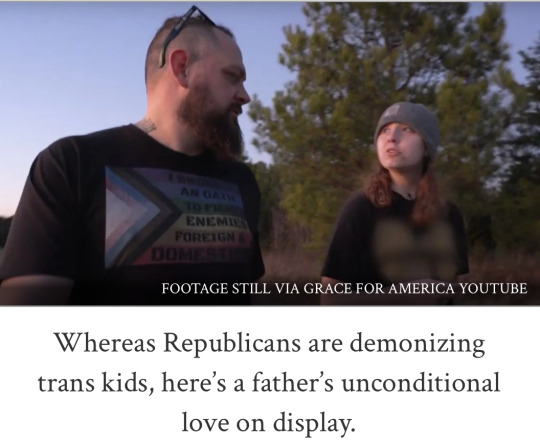
““Eric [“a conservative South Carolina U.S. Army combat veteran and father of a transgender child”] believed in the importance of freedom for trans kids — the right to live authentically and without fear,” [his widow] said. “He saw this not as a political issue but as a human one, recognizing that every child deserves the chance to thrive and feel whole.”” [Curator’s note: obviously, utmost condolences to Eric’s family; I’m including this as good news because it’s impactful to see a respectable member of the political party more often known for transmisia instead publicly advocating for his son’s human - not just political - rights]
5. Azores to create largest Marine Protected Area in North Atlantic – and a 'blueprint' for the rest of the world

““The Azores’ waters are a hotspot for marine life, hosting a third of the world's whale and dolphin species,[…” and harbouring] “cold-water corals and sponge fields that act as nurseries and feeding grounds for countless species, from deep-sea sharks to commercially valuable fish stocks.””
6. ‘It’s a big lever for change’: the radical contract protecting Hamburg’s green space

“Citizen power forced Germany’s greenest city-state into a binding agreement balancing housing and nature[….] The authorities signed an agreement with the citizen’s initiative to protect 30% of Hamburg’s land area – 10% as untouchable nature reserves and 20% with a looser conservation status – and ensure the share of public green space in the city rises over time.”
7. Behind the Scenes at the Federal Bee Lab Powered by Native Plants

“Once native plants reappeared at the lab, he says, the impact was dramatic. In the first year, many of the region’s 200 native bee species arrived in droves. [… B]irds Droege had never before seen on the premises began to turn up to feed on the native plant seeds[….]”
8. Atlanta neighborhood hired case manager to address rising homelessness. It's improving health and safety for everyone

“Michael Nolan, an Intown Cares social worker, is trained in an approach that emphasizes individual autonomy and dignity, recognizes that being homeless is a traumatic experience, and prioritizes access to housing. [… H]iring a social worker has enabled East Atlanta Village to resolve conflicts gently, through conversation and negotiation.”
9. Loggerhead Sea Turtle Nests Make a Remarkable Comeback in Greece

“As long-lived and migratory species, [loggerheads] contribute to the health of seagrass beds and coral reefs, which are vital habitats for many marine organisms. Their nesting activities also contribute to beach ecosystems and help promote biodiversity.”
10. Rapid genome analysis of a Whippet sighthound sets new standard for biodiversity research

“[Scientists] have sequenced and analyzed the complete genome of a Whippet sighthound in less than a week. […] Rapid analysis is increasingly important for the conservation of endangered species, [… giving] insights into their biological relationships, evolution and adaptations to environmental conditions.”
October 15-21 news here | (all credit for images and written material can be found at the source linked; I don’t claim credit for anything but curating.)
#hopepunk#good news#conservation#wildlife#habitat#habitat restoration#electric vehicles#waste management#crocodiles#reptiles#conservatives#veterans#trans rights#protect trans kids#human rights#ocean#whale#dolphin#shark#coral reef#germany#native plants#native bees#bees#homelessness#homeless#unhoused#sea turtle#dogs#genetics
40 notes
·
View notes
Text
Artfully arranged...

#living#interior design#home decor#livingroom#kitchen#loft#new york#atlanta#sartoriale#san francisco#italian style#elledecor#elle decor#upper east side#the village#palermo sicily#parisianstyle#homeinterior#homedesign#sprezzatura#pittiuomo#pitti uomo#pittibygwd#houston#sicily italy#interior#inspiration#interiors#design#dunhill
7 notes
·
View notes
Text
THIS DAY IN GAY HISTORY
based on: The White Crane Institute's 'Gay Wisdom', Gay Birthdays, Gay For Today, Famous GLBT, glbt-Gay Encylopedia, Today in Gay History, Wikipedia, and more … January 4



1750 – France Bruno Lenoir and Jean Diot are caught having sex in public for which they are arrested. A year later they were executed. There was general surprise in France at the severity of their sentence. Their execution was the last in France for consensual sodomy.


1877 – Marsden Hartley (d.1943) was an American Modernist painter, poet, and essayist. Hartley was born in Lewiston, Maine, where his English parents had settled.
In 1898, at age 22, Hartley moved to New York City to study painting at the New York School of Art. Hartley was a great admirer of Albert Pinkham Ryder and visited his studio in Greenwich Village as often as possible. His friendship with Ryder inspired Hartley to view art as a spiritual quest.
Hartley first traveled to Europe in April 1912, and he became acquainted with Gertude Stein's circle of avante-garde writers and artists in Paris. Stein, along with Hart Crane and Sherwood Anderson, encouraged Hartley to write as well as paint.
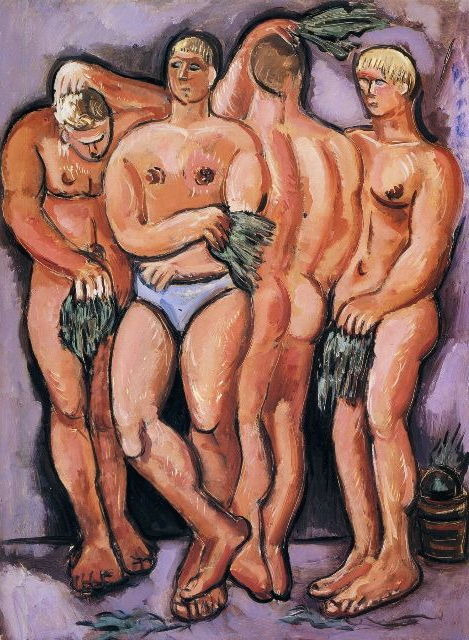
Finnish-Yankee sauna
In 1913, Hartley moved to Berlin, where he continued to paint. Many of Hartley's Berlin paintings were further inspired by the German military pageantry then on display, though his view of this subject changed after the outbreak of World War I, once war was no longer "a romantic but a real reality." The earliest of his Berlin paintings were shown in the landmark 1913 Armory Show in New York.
In Berlin, Hartley developed a close relationship with a Prussian lieutenant, Karl von Freyburg, who was the cousin of Hartley's friend Arnold Ronnebeck. References to Freyburg were a recurring motif in Hartley's work, most notably in Portrait of a German Officer (1914). Freyburg's subsequent death during the war hit Hartley hard, and he afterward idealized their relationship. Many scholars believe Hartley to have been gay, and have interpreted his work regarding Freyburg as embodying his homosexual feelings for him.
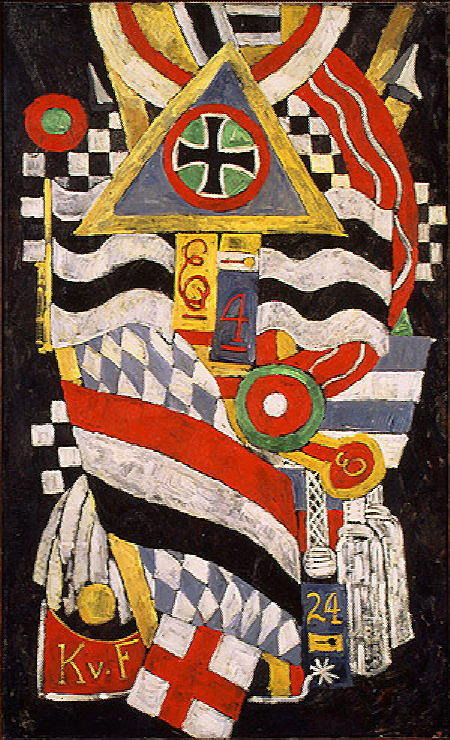
Portrait of a German Soldier
In addition to being considered one of the foremost American painters of the first half of the 20th century, Hartley also wrote poems, essays, and stories.
Cleophas and His Own: A North Atlantic Tragedy is a story based on two periods he spent in 1935 and 1936 with the Mason family in the Lunenburg County, Nova Scotia, fishing community of East Point Island. Hartley, then in his late 50s, found there both an innocent, unrestrained love and the sense of family he had been seeking since his unhappy childhood in Maine. The impact of this experience lasted until his death in 1943 and helped widen the scope of his mature works, which included numerous portrayals of the Masons.
He wrote of the Masons, "Five magnificent chapters out of an amazing, human book, these beautiful human beings, loving, tender, strong, courageous, dutiful, kind, so like the salt of the sea, the grit of the earth, the sheer face of the cliff." In Cleophas and His Own, written in Nova Scotia in the fall of 1936, Hartley expresses his immense grief at the tragic drowning of the Mason sons. The independent filmmaker Michael Maglaras has created a feature film Cleophas and His Own, released in 2005, which uses a personal testament by Hartley as its screenplay.

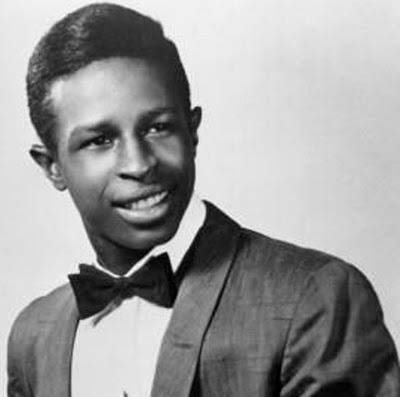
1946 – Arthur Conley aka Lee Roberts (d.2003) was a U.S. soul singer, best known for the 1967 hit "Sweet Soul Music".
Conley was born in McIntosh County, Georgia, U.S., and grew up in Atlanta. He first recorded in 1959 as the lead singer of Arthur & the Corvets. With this group, he released three singles in 1963 and 1964 – "Poor Girl", "I Believe", and "Flossie Mae" – on the Atlanta based record label, National Recording Company.
In 1964, he moved to a new label (Baltimore's Ru-Jac Records) and released "I'm a Lonely Stranger". When Otis Redding heard this, he asked Conley to record a new version, which was released on Redding's own fledgling label Jotis Records, as only its second release. Conley met Redding in 1967. Together they rewrote the Sam Cooke song "Yeah Man" into "Sweet Soul Music", which, at Redding's insistence, was released on the Atco-distributed label Fame Records, and was recorded at FAME studios in Muscle Shoals, Alabama. It proved to be a massive hit, going to the number two position on the U.S. charts and the Top Ten across much of Europe. "Sweet Soul Music" sold over one million copies, and was awarded a gold disc.
After several years of hits singles in the early 1970s, he relocated to England in 1975, and spent several years in Belgium, settling in Amsterdam (Netherlands) in spring 1977. At the beginning of 1980 he had some major performances as Lee Roberts and the Sweaters in the Ganzenhoef, Paradiso, De Melkweg and the Concertgebouw, and was highly successful. At the end of 1980 he moved to the Dutch village of Ruurlo, legally changing his name to Lee Roberts — his middle name and his mother's maiden name. He promoted new music via his Art-Con Productions company. Amongst the bands he promoted was the heavy metal band Shockwave from The Hague. A live performance on January 8, 1980, featuring Lee Roberts & the Sweaters, was released as an album entitled Soulin' in 1988.
Conley was gay, and several music writers have said that his homosexuality was a bar to greater success in the United States and one of the reasons behind his move to Europe and his eventual name change. In 2014, rock historian Ed Ward wrote, "[Conley] headed to Amsterdam and changed his name to Lee Roberts. Nobody knew 'Lee Roberts,' and at last Conley was able to live in peace with a secret he had hidden – or thought he had – for his entire career: he was gay. But nobody in Holland cared."
Conley died from intestinal cancer in Ruurlo, Netherlands aged 57 in November 2003. He was buried in Vorden.


1960 – Michael Stipe has been the lead singer, lyricist, and composer for the successful rock band R.E.M. for over two decades. Among his best-known songs is "Losing My Religion," which rose to number 4 on the United States rock charts in 1991. He has also become involved in film and now has his own production companies.
The child of a career military officer, John Michael Stipe, born in Decatur, Georgia, grew up on bases around the United States and also in Germany, and spent his high school years in Illinois.
Stipe returned to Georgia for college, enrolling as an art student at the University of Georgia in 1978. There he met fellow alternative music fans Peter Buck, Mike Mills, and Bill Berry. Within a year all four had dropped out of college to forge a career as a rock band, R.E.M.
They went on a concert tour and in 1980 put out their first single, "Radio Free Europe." Its success, particularly on college radio stations, won them a recording contract. Their first full-length album, Murmur (1983), was chosen as Album of the Year by Rolling Stone magazine.
Stipe's vigor on stage contributed to the success of R.E.M.'s concerts. He interacted with the audience and charged about with boundless energy. He blasted his often dark and brooding lyrics into the microphone with such force that they were frequently barely intelligible.
In addition to composing and performing, Stipe has also directed several of R.E.M.'s music videos and oversees the creation of their album covers.
By 2004 the band had recorded nearly twenty albums with collective sales of almost fifty million copies worldwide, making it one of the most successful in the history of rock music.
With the success of the albums Out of Time (1991) and Automatic for the People (1992), R.E.M. became mainstream music stars. Around 1992, rumors that Stipe had contracted HIV began to circulate. According to Stipe, he did not start the rumor and he does not know who did.
Not that I can tell. I wore a hat that said 'White House Stop AIDS'. I'm skinny. I've always been skinny, except in 1985 when I looked like Marlon Brando, the last time I shaved my head. I was really sick then. Eating potatoes. I think AIDS hysteria would obviously and naturally extend to people who are media figures and anybody of indecipherable or unpronounced sexuality. Anybody who looks gaunt, for whatever reason. Anybody who is associated, for whatever reason - whether it's a hat, or the way I carry myself -as being queer-friendly.
In 1994, with questions still swirling about his sexuality, Stipe described himself as "an equal opportunity lech," and said he did not define himself as gay, straight, or bisexual, but that he was attracted to, and had relationships with, both men and women.
In 1995, he appeared on the cover of Out magazine. Stipe described himself as a "queer artist" in Time in 2001 and revealed that he had been in a relationship with "an amazing man" for three years at that point. Stipe reiterated this in a 2004 interview with Butt magazine. When asked if he ever declares himself as gay, Stipe stated, "I don't. I think there's a line drawn between gay and queer, and for me, queer describes something that's more inclusive of the grey areas."
In 1999, author Douglas A. Martin published a novel, Outline of My Lover, in which the narrator has a six-year romantic relationship with the unnamed lead singer of a successful Athens, Georgia-based, rock band; the book was widely speculated, and later confirmed by its author, to have been a roman à clef based on a real relationship between Martin and Stipe. The two had previously collaborated on two books, both in 1998: The Haiku Year (for which the two had both contributed haikai) and Martin's book of poetry Servicing the Salamander (for which Stipe took the cover photograph).


1965 – Craig Revel Horwood is an Australian-British author, dancer, choreographer, conductor, theatre director, and former drag queen in the United Kingdom. He is also a patron of the Royal Osteoporosis Society.
Horwood is best known as a judge on the popular BBC dancing series Strictly Come Dancing, and until 13 November 2021, as he tested positive for COVID-19 and missed the following week's show, had been the only judge to have appeared in every edition since its inception. He is often seen performing ballroom and Latin routines including, in 2019, a performance themed around Hello, Dolly!.
Horwood has a waxwork in Madame Tussauds Blackpool which has been on display since July 2018. On 20 July 2021, Horwood was given an Honorary Doctor of Arts by the University of Winchester at Winchester Cathedral.
He was born in Ballarat, Australia. His father Phil was a former Royal Australian Navy Lieutenant whose alcoholism had "torn their family apart". He started his career as a dancer in Melbourne, then moved to London to take advantage of the greater opportunities available there and to dance competitively. In 1989, he moved to the UK from Australia, and on 20 August 2011, he became a British citizen.
Revel is Horwood's middle name; it is not double barrelled. In his autobiography, Horwood reveals that at the age of 17, he made money by appearing as a drag queen in bars and clubs and that his relationship with an unnamed celebrity was akin to prostitution.
Horwood was married to Jane Horwood from 1990 to 1992. In December 2014, Horwood informed a reporter from OK! magazine that 'I was bisexual for a long time. I flitted between men and women quite a lot between the ages of 17 and 26. My wife Jane left me for another man. Then I fell in love with a bloke. I have been gay ever since.' His former partner Damon Scott had been a runner up on Britain's Got Talent.
Since early 2018, Horwood has been in a relationship with horticulturist Jonathan Myring. In April 2020 Horwood and Myring announced their engagement. The pair, who met on Tinder, became engaged while in Tasmania.
Horwood became a patron of the Royal Osteoporosis Society in 2009. In this, he has found common ground with Camilla, Queen Consort, the Society's Royal patron (whose mother, like his, had bone disease). The two of them danced the cha-cha-cha together, on a school visit to mark National Osteoporosis Day in 2009.
In January 2015, Horwood revealed on ITV's Loose Women that he suffered from anorexia and body dysmorphia as a teenager and young dancer, as a result of trying to make himself look like other young men, and other dancers in particular.The 14th British series of Who Do You Think You Are? featured Horwood's ancestry in the second episode; in this, his family history research took him home to Australia, where he discovered that his family tree traces to Gloucestershire, Lancashire and Essex in England. Horwood found out that he is not the first dancer in his family, and that he is descended from gold prospectors that went bankrupt before becoming rich on finding a 250-ounce (7.1 kg) gold nugget. He also learnt further that his great-great-grandfather, Moses Horwood, who is revealed in the programme to have been a petty criminal from England, was convicted at the Gloucestershire assizes and transported to Van Diemen's Land (Tasmania) in 1841. Criminal records identified by TheGenealogist include a transportation document for Moses Horwood, showing he departed England on 1 December 1841 on board a ship called the John Brewer.


1970 – Christopher Klucsarits, better known as Chris Kanyon (d.2010), US Professional wrestler, best known for his work in World Championship Wrestling and the World Wrestling Federation, under the ring names Kanyon and Mortis.
In 2006, after Kanyon's release from WWE, he began a gimmick in which he was an openly homosexual pro wrestler. This included a publicity stunt wherein he stated that WWE released him from his contract because of his sexuality. Kanyon later told reporters and even stated on a number of radio interviews, that this was just a publicity stunt and he was heterosexual. However, he later retracted these statements and acknowledged that he was in fact homosexual.
Before his death Kanyon was working on a book, Wrestling Reality, with Ryan Clark. The book was released November 1, 2011, and it features Kanyon's struggles as a closeted gay man as a prominent theme.


1984 – Illinois repeals its "lewd fondling or caress" law, more than two decades after repealing its sodomy law.


1997 – A British tabloid accuses Conservative M.P. Jerry Hayes of having an affair in 1991 with a then-18-year-old male. At the time, 18 was under the age of consent.


18 notes
·
View notes
Text
DO YOU:
enjoy burlesque?
hate cancer?
Then you should make plans to be in Atlanta on the 26th of April for COURAGE CABARET, a charity burlesque show to raise funds for Sam's treatment!
doors open at 7:30, show starts at 8
tickets are $20 in advance, $25 at the door
This event is being held by Metropolitan Studios Arts & Movement Community, a queer-woman owned dance studio in East Atlanta Village. Tickets and other event details available HERE at Eventbrite, and a list of performers in this tiktok! We're beyond grateful to everyone who's helped us set this up, and hope you'll come out to enjoy and support!
23 notes
·
View notes
Text
Pedestrian & transit conditions should shine where affordable homes are funded
Darin Givens | April 13, 2024
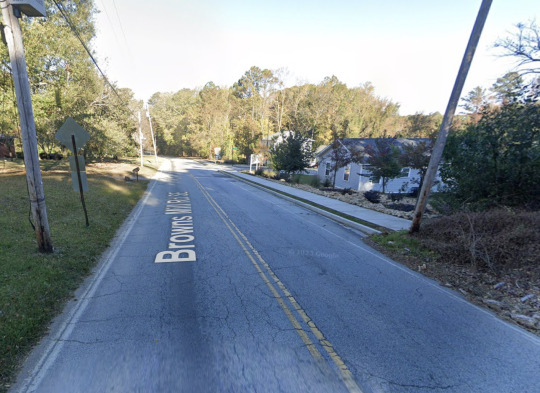
According to WSB news, Senator Jon Ossoff recently announced that $2 million in federal funds will create 20 new affordable housing units in Atlanta. In general, I think that's a really good use of public money.
But I do have concerns about the location...
The homes will be inside the Browns Mill Village development in south Atlanta; pictured is the entrance to it on Browns Mill Road.
Per Google Maps, it takes 1.5 hrs to get from here to Midtown on MARTA, versus an 18 minute drive. Or it's a mile walk to the stop for the 78 bus to East Point (46 minutes total, or more if you don't walk fast), but only a 15 minute drive.
And as you can see, pedestrian conditions are awful.
I don't mean to dismiss this project. There are definitely good things about it. But at the same time, I want us to cast a critical eye on initiatives that fund new affordable homes in car-centric places with streets that are hostile pedestrians and that lack high frequency transit.
Meanwhile, the most walkable and bikeable places in the city have become less affordable. This is a toxic trend.
We have got to find a way to match these major investments in affordable housing with great access to alternative transportation, particularly with transit services that are often a lifeline for lower income residents. Maybe it's a case of ensuring that pedestrian and transit improvements are made in a place like this to coincide with the investment.
Whatever the fix is, we need to accept this as a problem and aim higher.
If this incident was a one-off, I wouldn't be so worked up. But this is a definite trend of failing to match affordable housing investments with great pedestrian infrastructure and high frequency transit. It needs to be called out and addressed.
13 notes
·
View notes
Text

There's a lot of history in this view from the King Memorial MARTA Station's northbound platform.
On the far left is a symbol of Atlanta's industrial history: the Fulton Cotton Mill complex, which was transformed into lofts about 25 years ago. The mill was built in stages from the 1880s to 1907 and was surrounded by the mill village that we now know as the Cabbagetown neighborhood. It produced large cotton bags to hold seed & feed, for farms.
At the bottom is the east-west rail corridor that dates to the beginnings of Atlanta in the 1830s, when the state decided to build new rail lines east to Augusta and north to Chattanooga, which were designed to meet in the spot where the city was then formed.
And at top right you can see the beautiful Oakland Cemetery, the footprint of which grew in stages from 1850 to 1866. It started as a small local cemetery of six acres and transformed into the tree canopied, grand space we know today. Interesting historical tidbit: the reason it's fully enclosed on all sides is "bovine infestation." Meaning: cows were wandering in to graze.
The cemetery, the mill property (plus Cabbagetown), and the rail corridor have been coexisting since the 1880s. For over 140 years, people have looked out of train windows to see these elements of Atlanta's history. Take a look next time you're rolling by on MARTA and ponder the history.
18 notes
·
View notes
Text

@strxngetimes gets a plotted starter
THERE ARE SIGHTINGS OF A GHOST DOG IN NEW YORK. It's a little too unbloody to be a hellhound, but they want to make sure, anyway, so they pile into the Impala and head east. 100 miles past Louisville, Sam gets a call from a hunter wanting help with a big vampire nest in Atlanta. Castiel tells the brothers that he can start on the ghost dog case while they decapitate the fangs, but honestly, it's easier said than done. He interviews the people who claim to have seen the dog, but it doesn't give him any clues whatsoever. The animal doesn't appear to be aggressive. Maybe it's an omen of impending death?
Then he finds the police report of a cyclist who crashed into a street lantern because the ghost dog popped up right in front of him. Castiel visits the man in the hospital and listens to his graphic story of how the canine walked through the wall of a building and an oncoming car. Because he doesn't have anything else to go on, Castiel visits the scene of the accident, 177A Bleecker Street in Greenwich Village, and rings the doorbell. Maybe the residents have seen something.

19 notes
·
View notes
Text


East Atlanta Village always has my poor little phone camera fighting for its life
#blurry on purpose it is!#juna atl#juna band#pupshow#speaking#I had others but I like this layout best#529 eav
5 notes
·
View notes
Text




East Atlanta Village on digicam.
7 notes
·
View notes
Photo

Well, I’m retry much back from the grave. I had my tonsils and adenoids taken out 2/15 and it impacted me waaaay more than I thought it would. I’m sorry for the radio silence, I’m still arting and trying to human again. I’m gonna be set up tomorrow (3/4) for Middle Earth Market in East Atlanta Village. Than next weekend I’ve got two markets lined up! I’ll be at Drawn and Disorderly on Saturday 3/11 & at Stillfire Brewery on Sunday 3/12. My newest print is premiering tomorrow. The idea came from me feeling a certain type of way about some events in the news as of late, and my love of pancakes which I could not eat until very recently. I hope to see you soon, more markets will be posted as the dates approach. Thank you for the follows, the likes and the support. It means a great deal and I’m honored by your kindness. Happy Friday y’all. #popupmarket #artmarket #popart #queerart #funart #sillyart #atlantaartist #indieart #kirkwoodsmallbiz #octopusart #decaturartist #illustrative #supportlocalartists #eav #cryptidcreatives #southernartists #drawnanddisorderly #stillfirebrewery #sudnatstudio #eatbreakfast #punchtransphobes #benstigator #happycupstudio https://www.instagram.com/p/CpWpjmpuFKE/?igshid=NGJjMDIxMWI=
#popupmarket#artmarket#popart#queerart#funart#sillyart#atlantaartist#indieart#kirkwoodsmallbiz#octopusart#decaturartist#illustrative#supportlocalartists#eav#cryptidcreatives#southernartists#drawnanddisorderly#stillfirebrewery#sudnatstudio#eatbreakfast#punchtransphobes#benstigator#happycupstudio
6 notes
·
View notes